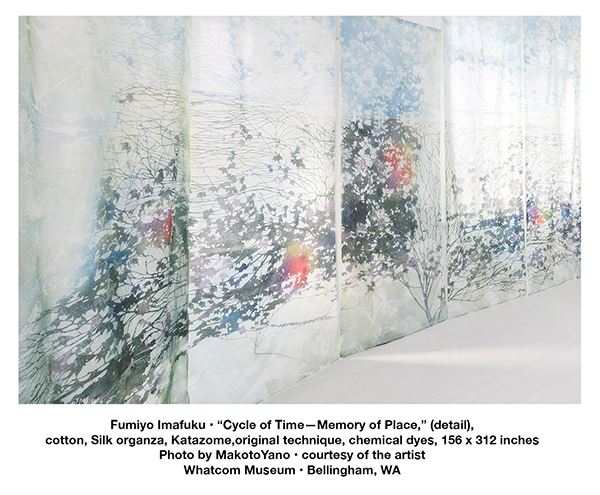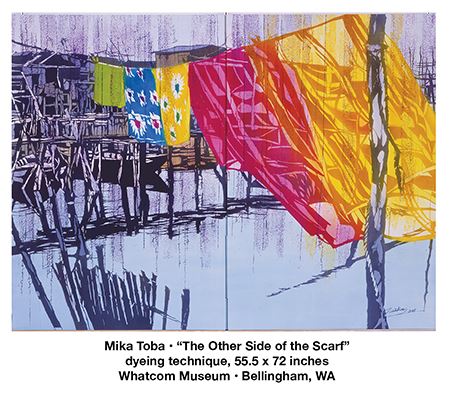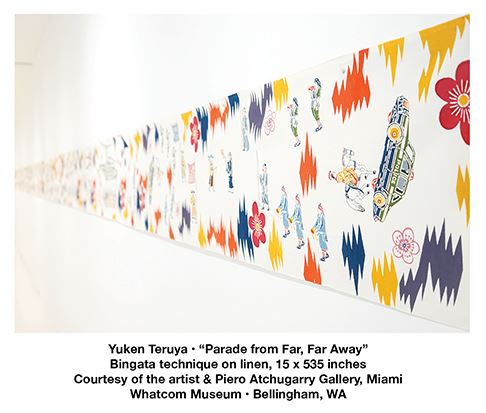 In the Spring of 2023, the Whatcom Museum presents “Katazome Today: Migrations of a Japanese Art” in the Lightcatcher Building. The exhibition features the work of seven national and international artists who all explore katazome, a Japanese textile dyeing process, in their work. While traditionally used for kimono dyeing, this process continues to be used as an expression of creativity by artists around the world. By tracing the international migration of this historical method, the exhibition offers the guest an opportunity to explore the evolution of a dyeing process as it interacts with various cultures and environments throughout the global artistic community. The exhibition is co-curated by Seiko A. Purdue, Professor in Fibers/Fabrics at Western Washington University and Amy Chaloupka, Curator of Art at the Whatcom Museum.
In the Spring of 2023, the Whatcom Museum presents “Katazome Today: Migrations of a Japanese Art” in the Lightcatcher Building. The exhibition features the work of seven national and international artists who all explore katazome, a Japanese textile dyeing process, in their work. While traditionally used for kimono dyeing, this process continues to be used as an expression of creativity by artists around the world. By tracing the international migration of this historical method, the exhibition offers the guest an opportunity to explore the evolution of a dyeing process as it interacts with various cultures and environments throughout the global artistic community. The exhibition is co-curated by Seiko A. Purdue, Professor in Fibers/Fabrics at Western Washington University and Amy Chaloupka, Curator of Art at the Whatcom Museum.
 One of the most exciting aspects of “Katazome Today” is the inclusion of a national and international roster of artists: Akemi Cohn (Illinois), Melinda Heal (Australia), Fumiyo Imafuku (Japan), Cheryl Lawrence (Washington), John Marshall (California), Yuken Teruya (Germany), and Mika Toba (Japan).But before entering the exhibition, guests encounter “Dadai: Generation After Generation,” a display of artworks created by Professor Purdue’s students at Western Washington University. The students all utilize the katazome process in their own unique way as an illustration of the importance of passing key artistic knowledge from the teacher (Professor Purdue) to the next generation. The colorful pieces each highlight a motif created by the artist and lead the museum visitor to the entrance of the exhibit.
One of the most exciting aspects of “Katazome Today” is the inclusion of a national and international roster of artists: Akemi Cohn (Illinois), Melinda Heal (Australia), Fumiyo Imafuku (Japan), Cheryl Lawrence (Washington), John Marshall (California), Yuken Teruya (Germany), and Mika Toba (Japan).But before entering the exhibition, guests encounter “Dadai: Generation After Generation,” a display of artworks created by Professor Purdue’s students at Western Washington University. The students all utilize the katazome process in their own unique way as an illustration of the importance of passing key artistic knowledge from the teacher (Professor Purdue) to the next generation. The colorful pieces each highlight a motif created by the artist and lead the museum visitor to the entrance of the exhibit.
Visitors are immediately greeted by a wide range of sizes, colors, and materials upon entering “Katazome Today.” Those unfamiliar with the process may be surprised by the variety of work included in the exhibition, which is excellently evident in the first gallery. Melinda Heal’s “The Cliffs, they are breathing” is one of the first artworks that visitors will experience upon entering the gallery and it includes imagery of the cliffs near the Australian town of Bermagui. The scale of the cliffs is referenced in the sheer scale of the artwork. According to the artwork label, this is the largest work Heal has created using the katazome technique so far in her artistic career.
 Heal’s expressive and graceful work is installed adjacent to another large work by Washington-based artist Cheryl Lawrence, titled “Women of the 116th Congress.” Created by a group of twenty women gathered by the artist, this installation documents the 113 women of the 116 th Congress, which was the most women sworn into Congress in a session. Each portrait is detailed with thread, buttons, and other beaded embellishments to create unique and personalized tributes to the 113 women in the installation.
Heal’s expressive and graceful work is installed adjacent to another large work by Washington-based artist Cheryl Lawrence, titled “Women of the 116th Congress.” Created by a group of twenty women gathered by the artist, this installation documents the 113 women of the 116 th Congress, which was the most women sworn into Congress in a session. Each portrait is detailed with thread, buttons, and other beaded embellishments to create unique and personalized tributes to the 113 women in the installation.
Figurative work is rare in this exhibition, and that makes this artwork even more impressive. Lawrence made an empowering and historically significant decision to bring together a group of women to create this work, and the artwork label connects this act to the tradition of women gathering in groups to create quilts throughout history.
The katazome process includes hand-cut stencils (katagami is the type of paper used) on which a dye-resistant rice paste is applied to then dye the fabric. The exhibition does include a video and photographs of the process to assist the guest in understanding this process in application. Interestingly, some artists in the exhibition utilize only a part or step of the katazome process to make their work.
 Yuken Teruya’s “Golden Arch Parkway McDonalds (Red Yellow)” is made up of a McDonald’s paper bag and glue, but Teruya hand-cuts the paper bag to create a tree within the bag by employing his understanding of cutting katagami stencils. The exhibition also includes katagami stencils from the early 1900s as examples of the traditional method.
Yuken Teruya’s “Golden Arch Parkway McDonalds (Red Yellow)” is made up of a McDonald’s paper bag and glue, but Teruya hand-cuts the paper bag to create a tree within the bag by employing his understanding of cutting katagami stencils. The exhibition also includes katagami stencils from the early 1900s as examples of the traditional method.
“Katazome Today: Migrations of a Japanese Art” draws from an international roster of artists who are all using a traditional technique to demonstrate contemporary ideas in a unique way. Whether they use the process in its entirety or select elements of the historical method, each artwork and installation brings the viewer to a closer understanding and appreciation for an artform that was carefully preserved for generations. The artworks range greatly in size, material, and form, which makes for an interesting and unexpected viewing experience for those new to katazome and guests already knowledgeable about the process. The exhibition is open until June 11, so there is still plenty of time to experience it for yourself and learn something new about this important Japanese artform.
 Chloé Dye Sherpe
Chloé Dye Sherpe
Chloé Dye Sherpe is a curator and art professional based in Washington State.
“Katazome Today: Migrations of a Japanese Art” is on view Wednesday through Sunday from noon to 5 P.M. through June 11 at Whatcom Museum located at 250 Flora Street in Bellingham, Washington. For more information, visit www.whatcommuseum.org.